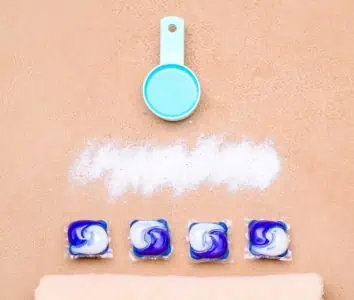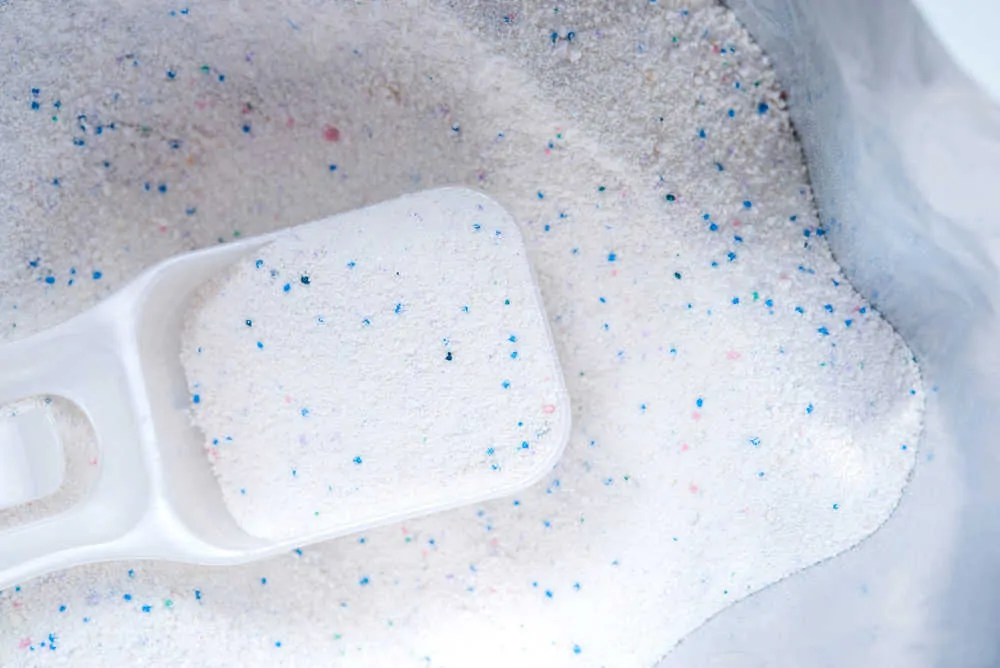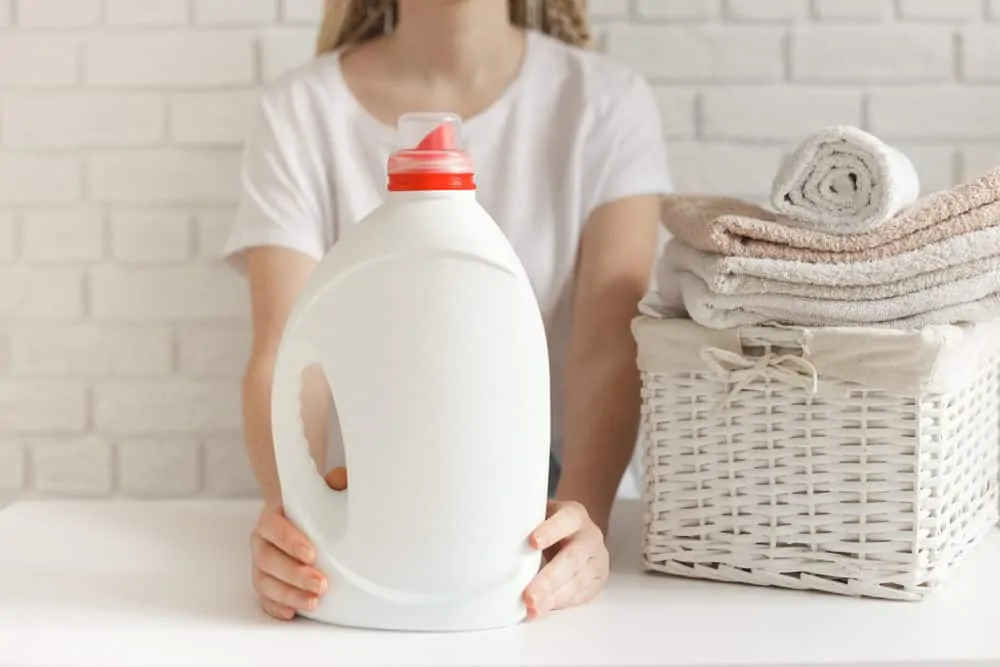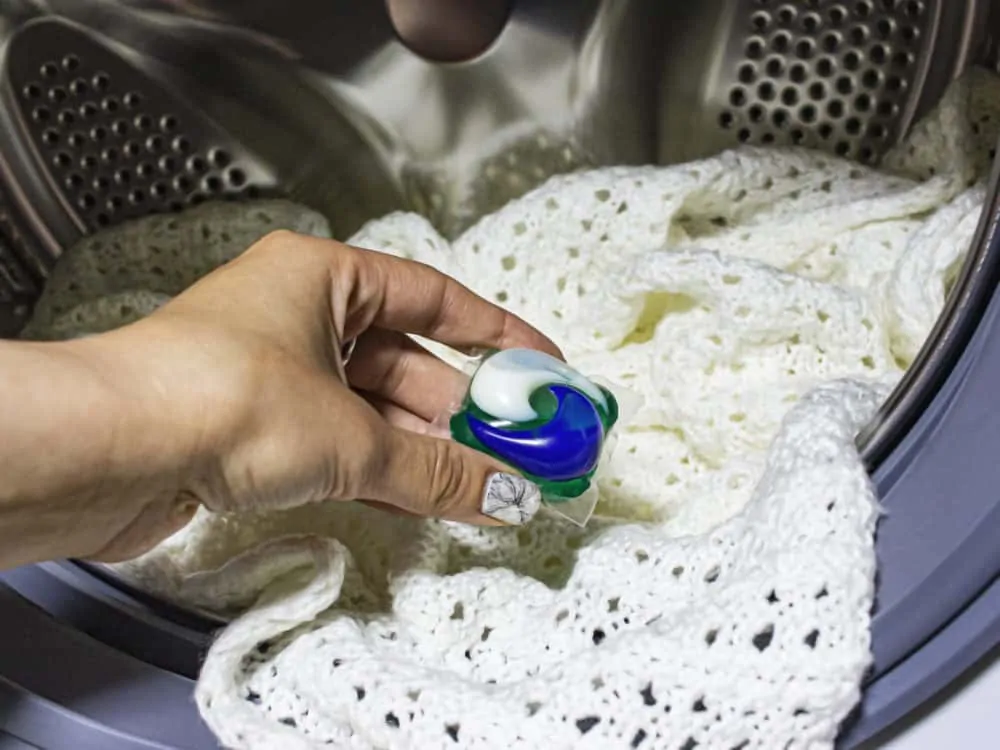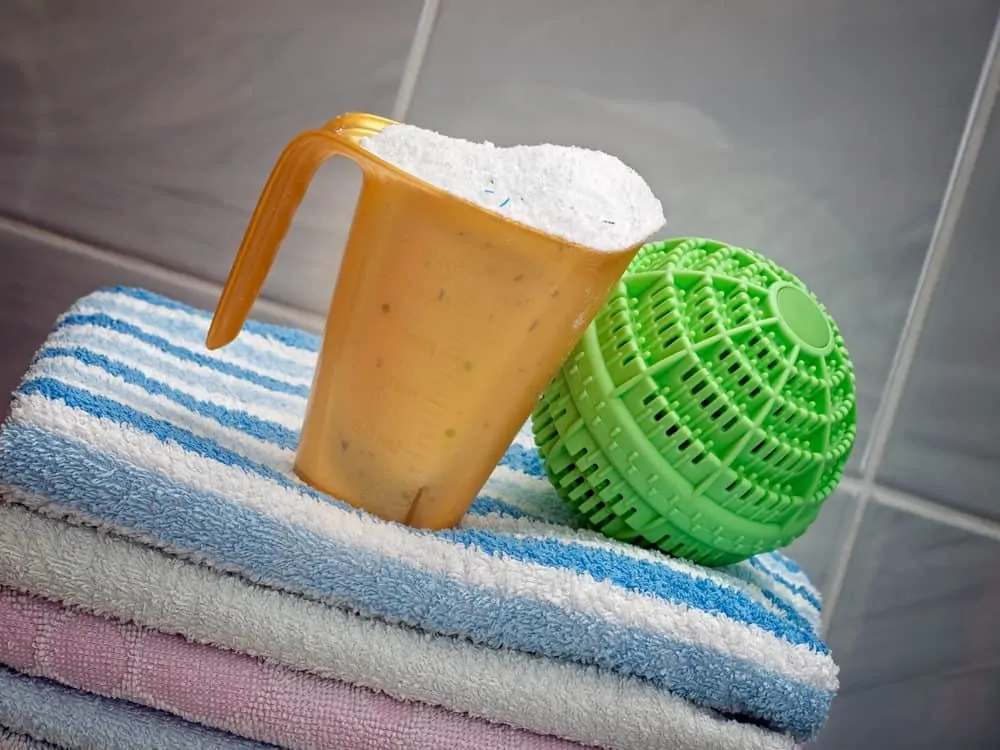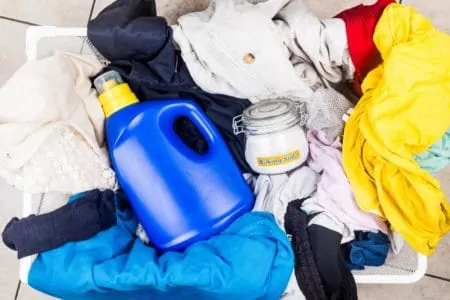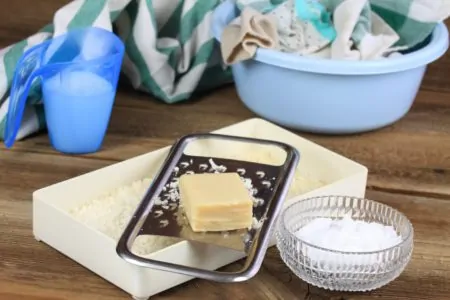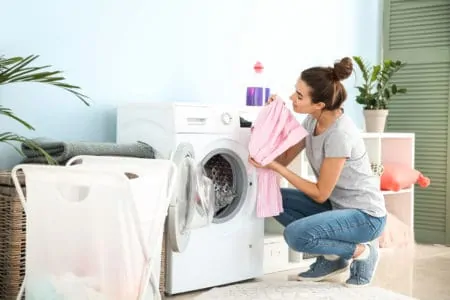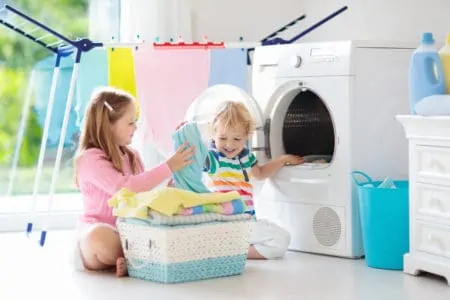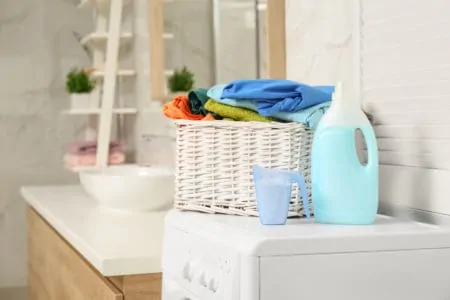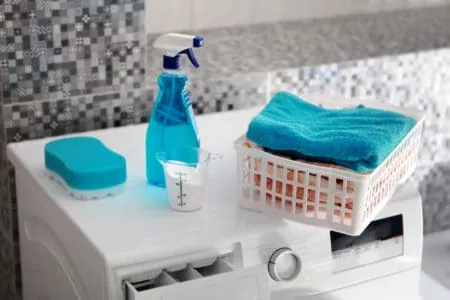Powder, liquid, pods, and tablets… These are the four main types of laundry detergents available. But that’s not all, there are many more.
Next time you’re shopping for detergent, you’ll know the pros, cons, and key facts of all the main types. Maybe you’ll find something that’s better suited to your laundry routine.
Stay tuned for our ultimate guide on the different types of detergent and what key factors to look out for.
Key Takeaways
- Laundry detergents come in four main types: powder, liquid, pods, and tablets.
- Eco-friendly and hypoallergenic detergents are available for those with sensitivities or environmental concerns.
- Detergents work by using surfactants, enzymes, bleaches, brighteners, and builders to remove stains and dirt from clothes.
- Choose laundry detergent based on factors like washing machine type, water temperature, skin sensitivity, scent, and eco-credentials.
What Is the Difference Between Soap and Detergent?
You might see laundry soap and laundry detergent advertised by retailers. But what’s the difference?
Both soap and detergent get your clothes clean, but they do their job differently.
Laundry detergent is made up of more synthetic compounds, such as petroleum-derived sulfates, optical brighteners, dyes, perfumes, phosphates, and other substances (1). They may also contain some biodegradable ingredients, such as enzymes, but in general, the entire concoction won’t be biodegradable.
Laundry soap, often referred to as an eco-friendly or natural detergent, is made of a mixture of fat and oils. You can make your own laundry soap or buy it from a retailer. It’s natural, biodegradable, and eco-friendly, although not as effective as laundry detergent. However, this is improving as time goes on.
Types of Laundry Detergent
There are four main types of laundry detergent, and the main difference is their physical form rather than their ingredients. Both laundry detergent and laundry soap can be found in these forms.
1. Powder
Powder detergent is a popular choice as it’s one of the cheapest options. It usually comes in a cardboard or tin box that is easily recyclable, too.
Pros
- It’s one of the cheaper options.
- Recyclable containers.
- Great for stain removal.
- Brightens and whitens clothes.
- Many contain oxygen bleach which can’t be found in liquid (2).
Cons
- You have to measure it out yourself, and it can be messy.
- Some brands can leave behind a film residue.
- Some brands of powder detergent don’t dissolve fully in cool cycles.
- If the box gets wet, it can break and leak.
- Pre-treating stains is a lengthier process.
2. Liquid
Liquid detergents are a hit with many households. They’re easy to use, effective and they come in a huge range of options.
Pros
- Great for pre-treating stains prior to the washing cycle.
- Different options for colors, whites and darks.
- Easy to dissolve in the cycle.
- Works in all temperatures.
- Most are effective on greasy stains.
- Easy to clean up spills and it’s okay if the carton gets wet.
Cons
- More expensive than powder.
- They usually come in plastic packaging.
- They don’t always come with handy measuring units. It can be hard to know how much to use for small, medium or big loads.
3. Pods
Laundry pods are a convenient and easy form of laundry detergent. If you’re new to laundry, or traveling, this is our top recommendation.
Pros
- Convenient, pre-measured, pod form.
- Great for traveling, since you can just take the amount you need.
- Not messy.
- Many are multi-function including stain removal, odor removal, color brightener, and detergent.
- They’re more concentrated, so you’re not paying for a product that’s mostly water.
- Long shelf-life.
- The coating is biodegradable.
Cons
- There is no pre-treatment option, so you can’t pretreat a stain.
- They are the most expensive option.
- Hazardous; children and pets may mistake them for candy. Always keep them out of reach from pets and children.
- You can’t adjust the portion for smaller loads. For bigger loads, you need to use more pods.
4. Tablets
Laundry tablets are a less popular version of laundry pods. They are very similar, but come in a slightly different form. Typically, they come without a protective coating and don’t contain liquid or gel. Instead, they are more powdery, like a dishwashing tablet.
Pros
- Pre-measured and convenient.
- Great for traveling, even just to the laundromat.
- They don’t create mess.
- Many options for sensitive skin.
Cons
- There are fewer tablet options than pods.
- No pre-treatment option for stains.
- May be ineffective and fully soluble in cooler cycles.
- Can’t be broken up for smaller loads.
Other Types of Laundry Detergent
Powder, liquid, pods and tablets are only a few of your options. There are many more choices to choose from.
These next types can come in different forms: pods, tablets, powder and liquid. In contrast, however, they tend to have varying functionalities.
5. Laundry Balls
Laundry balls, or laundry eggs, are a radical movement in the laundry room. You can pop this laundry ball into the washing machine and it will clean your clothes, toxin-free.
Plus, you can reuse these up to 210 times, depending on the product you choose. It’s the most eco-friendly, zero-waste option out there. Plus, they work so well. We’ve been using ours for months and couldn’t be happier with the results.
6. Eco-Friendly Detergents
Eco-friendly detergents are more akin to laundry soaps. They don’t contain as many as the harsh chemicals that regular detergents do. They mainly use plant-based ingredients to clean your clothes.
Just watch out though. Just because a product has “plant-based ingredients” on the packaging, doesn’t mean it’s 100% plant-based ingredients. For example, Tide’s Purclean detergent is only made up of 75% plant-based ingredients (3). The other 25% are synthetically derived.
Currently, there aren’t regulations enforcing brands to disclose their complete ingredient list for “plant-based detergents”. Therefore, it’s safe to assume they won’t be 100% plant-based. Many plant-based ingredients need synthetic ingredients to boost their abilities. For example, preservatives are commonly added to detergent to prevent mold and bacteria growth.
Keeping this in mind, eco-friendly detergents still do an awesome job. And if you learn how to read ingredients, you’ll definitely be able to find 100% plant-based detergents.
While they may be more expensive, they’re kind on your skin, the air in your home and the environment. We recommend eco-friendly detergents for every household but specifically if you have allergies, asthma or young children.
7. Hypoallergenic Detergents
Hypoallergenic laundry detergent is ideal for folks who have allergies or asthma. Usually these detergents are dermatologically tested and certified as safe on the skin.
They’re usually free from common allergens such as enzymes and fragrances (4). So if you have had allergic reactions to your previous detergent, definitely look out for a hypoallergenic option.
8. Biological Detergents
Biological detergents contain enzymes that break down tough stains (5). However, we don’t recommend using them on baby clothes or if you have sensitive skin as they’re not as gentle as other types of detergents.
9. Non-Biological Detergents
Non-biological detergent is free of biological enzymes (6). This detergent can be kinder on your skin and clothes. However, because of the lack of enzymes, they might not be as effective at removing tougher stains.
10. Color-Safe Detergents
Color-safe detergents are designed to keep your colored clothes in good condition. They brighten color and prevent clothes from fading while still removing stains and dirt. We recommend having a detergent that is good for both colors and whites, whether that’s a combination product or two separate products.
11. Detergent for Delicates
Delicate items need to be treated more gently than cotton and linen items. These detergents are ideal for wool, silk and underwear garments.
Delicate detergents typically don’t contain harsh chemicals such as sulfates or chlorine bleaches. If scented, they use essential oils rather than synthetic fragrances.
How Do Detergents Work?
Detergents are added to your washing machine because water alone cannot remove all dirt and stains. There are some main components in laundry detergents that allow them to function effectively:
- Surfactants: Soap molecules have a water-loving and an oil-loving end (7). When they are introduced to water, they bind with both water and oil molecules simultaneously. These soap molecules are a type of surfactants, which decrease the surface tension between the water and oil, so when they’re rinsed away, the soap breaks apart grease and dirt from the water.
- Enzymes: Enzymes are good for removing lots of stains. There are many different types of enzymes, but in general, enzymes break down stains into smaller particles so they can be lifted and washed away (8).
- Bleaches: Many laundry detergents contain bleach, whether chlorine or oxygen-based. Bleach de-colors stains rather than lifts them away so they can’t be seen anymore.
- Brighteners: Many detergents contain brighteners instead of bleach. This brightens clothes. For whites, it uses blue dyes to make the fabric look less yellow.
- Builders: Builders are added to detergents to reduce water hardness. They also help with stain removal, by balancing out the pH level in the cycle. Lastly, they emulsify grease and oil stains, break it apart, loosen it and then clean it away.
Overall, laundry detergent is an essential part of cleaning your clothes. There are many plant-based detergents and enzymes, so if eco-friendliness is a priority, don’t worry. Your clothes will still be sparkling clean.
FAQs
What’s Your Type?
With all the different types of detergents, it can be overwhelming to make a decision. But now that you know the main differences, pros and cons, you’ll be able to find your ideal match.
Every brand works a little differently, so make sure you read their fine print and customer reviews to make sure you’re getting something worth your money.
